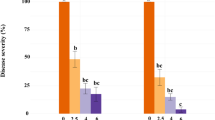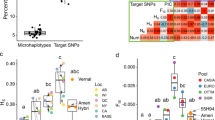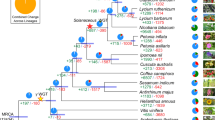Abstract
In the past, numerous Cf genes have been reported in tomato (Lycopersicon esculentum Mill.) that confer resistance against leaf mould (Cladosporium fulvum Cke.). We are interested in genetic variation at Cf loci. Therefore, previously uncharacterized Cf genes were further analysed. Recognition of the AVR4 elicitor, DNA gel blot analysis, PCR analysis and sequencing of part of the Cf-4 locus showed that a large proportion of the accessions tested harboured the Cf-4 resistance gene. We concluded that despite differences in nomenclature, all these accessions harbour the same Cf-4 locus, probably introgressed from the same donor. The origin of the Cf-4 locus and the reasons for discrepancies with earlier reports are discussed.
Similar content being viewed by others
Introduction
The interaction between tomato (Lycopersicon esculentum Mill.) and its fungal pathogen Cladosporium fulvum Cke., causing leaf mould, complies with the gene-for-gene relationship (Van den Ackerveken & De Wit, 1994). Breeding for resistance against this fungal pathogen dates back to the early 1930s when the first gene, Cf-1, was identified in a cultivated tomato line (Langford, 1937). Resistance conferred by Cf-1 was rendered ineffective by adaptation of the pathogen within a few years, which prompted breeders to introduce another gene (Cf-2) which was also rapidly rendered ineffective. The introduction of new Cf genes and the occurrence of new races made continuous breeding for resistance inevitable. This effort resulted in the introgression of numerous Cf genes in tomato cultivars. Often, one Lycopersicon accession was used as the donor of several different Cf genes (Kanwar et al., 1980a,b), whereas for other Cf genes, e.g. Cf-11, the original donor could not be determined (Kerr et al., 1980). As a consequence, there is much confusion about the designation of Cf genes. For example, Cf-4 was thought to originate from L. hirsutum 3833 (Kerr & Bailey, 1964; Thomas et al., 1997), but L. peruvianum and L. pimpinellifolium were also reported to harbour a gene that conferred resistance to a similar spectrum of C. fulvum races (Kerr & Bailey, 1964). Moreover, it was found that the genotype supposed to harbour Cf-8 contained a Cf resistance gene, which conferred resistance to a similar spectrum of C. fulvum races as Cf-4 (Gerlagh et al., 1989). Meanwhile, the resistance genes Cf-4 and Cf-9 and their corresponding Avr genes have been isolated (Van den Ackerveken et al., 1992; Jones et al., 1994; Joosten et al., 1994; Thomas et al., 1997). Cf-4 and Cf-9 reside in a cluster of Cf homologues on the short arm of chromosome 1, designated ‘Milky Way’ (Parniske et al., 1997). The Cf-4 cluster harbours two functional resistance genes, Cf-4 and Hcr9-4E (Cf-4A according to Takken et al., 1998). Moreover, other clusters of Cf homologues have been identified on the short arm of chromosome 1 (Parniske et al., 1999). We are interested in characterizing additional Cf genes on the short arm of chromosome 1. One challenging question is raised by the reports that Cf-4 is present in several different Lycopersicon species (Kerr & Bailey, 1964). Either Cf-4 originates from an ancient common ancestor and was present before these species diverged, or Cf-4 evolved independently in different Lycopersicon species. If these species harbour different Cf-4 alleles that all recognize AVR4, the sequence variation in these alleles could provide information about sequences that are necessary for AVR4 recognition. We have screened 64 accessions reported to contain Cf resistance for the presence of Cf-4 by infection with transgenic PVX, expressing the Avr4 gene. In this report we present the results of the screening with PVX::Avr4 and the subsequent analysis of the Cf-4 locus in accessions harbouring a functional Cf-4 gene. The results are discussed in the scope of breeding history, nomenclature and the origin of Cf-4.
Materials and methods
Plant material and PVX assays
We screened 64 out of 66 available Lycopersicon genotypes with reported Cf resistance for the presence of a functional Cf-4 gene using PVX::Avr4 assays (Haanstra et al., 1999). The L. esculentum accessions LA2443 and LA3047 were not tested. Accessions which showed systemic necrosis upon infection with PVX::Avr4 are listed in Table 1. We considered the genotypes L. esculentum G1.1148 and LA3045 as controls, because they have been reported as being Moneymaker-Cf4 and the Cf-4 gene was isolated from this genotype (Thomas et al., 1997). The genotype L. minutum CGN15815 was not further analysed since two-week-old seedlings were too small to determine the reaction of this accession to PVX::Avr4 unambiguously.
DNA isolation and Southern analysis
Gel blot analysis using genomic DNA isolated according to the protocol described by Van der Beek et al. (1992) was performed as described by Thomas et al. (1997).
DNA sequence analysis
A 1500-bp fragment was amplified by PCR using the forward primer GAG TTC AAG TCC AAA ACA TTA AGT A and the reverse primer TTT TAT CTG CAT CCC AAG CAA CTG, which amplified the 3′ part of the Cf-4 gene as well as part of the untranslated 3′ region (Fig. 1). The PCR product was cloned into the pGEM-T Easy vector (Promega, Leiden, The Netherlands). The cloned fragments were prepared for sequence analysis using the primers T7 and SP6 in a reaction using the PRISM Ready Reaction DyeDeoxy Terminator Cycle sequencing kit (Applied Biosystems, La Jolla, CA). Sequence products were run on an automated sequencer (model 373 A; Applied Biosystems) and aligned using the software module MEGALIGN (DNAStar Inc.) for sequence comparison. Each clone was sequenced twice.
Position of the primers used for sequencing the 3′ end of the Cf-4 gene and 200 bp of the 3′ untranslated region (UTR) in the tomato genotypes 3–17 of Table 1. The size of each Hcr9 ranges from 2.2 to 2.6 kb, whereas the size of the intergenic regions is between 4.0 and 7.1 kb.
Results
Presence of a functional Cf-4 gene
Of the 64 lines tested 17 exhibited systemic necrosis upon infection with PVX::Avr4 (Table 1). Surprisingly, the accession L. esculentum CN0697 (V541), reported to harbour Cf-4 from L. peruvianum (Bailey & Kerr, 1964), showed no systemic necrosis upon PVX::Avr4 infection. Of these 17 accessions, 10 have been reported to harbour Cf-4 (nos 1–4 and 9–14 from Table 1). In addition, three L. esculentum accessions with unidentified resistance reacted to PVX::Avr4, indicating that these accessions also harbour an active Cf-4 gene. As expected, both accessions reported to harbour the gene Cf-8, as well as the accessions reported to harbour the genes Cf-11 and Cf-13, respectively, exhibited systemic necrosis upon infection with PVX::Avr4, indicating a functional Cf-4 gene. Previously it has been reported that Cf-8 was indistinguishable from Cf-4 (Gerlagh et al., 1989). On the other hand, Cf-11 previously showed a differential interaction upon inoculation with different races of C. fulvum, and was resistant to race 2.4.5 (Lindhout et al., 1989).
Southern analysis of the Cf-4 locus
The accessions that exhibited necrosis upon infection with PVX::Avr4 were reported to harbour Cf genes originating from various donors (Table 1), as well as several lines with multiple Cf genes (Bailey & Kerr, 1964). In order to examine the presence of Cf homologues in these accessions, we performed Southern analysis using the 5′ end of Cf-9 (Jones et al., 1994) as a probe on BglII digested genomic DNA (Fig. 2). All lines do not only harbour a Cf-9 hybridizing band with exactly the same mobility as the Cf-4 gene, but alsoa band at the same position as the Hcr9-4E gene, which is located downstream of Cf-4 (Thomas et al., 1997). These results imply that not only Cf-4, but also Hcr9-4E is present in these lines. Except for the L. esculentum accessions CN0354 (V501) and CN6766 (Cf-13), which contain two and one additional hybridizing bands, respectively (indicated with * in Fig. 2), the hybridization patterns of lines containing a functional Cf-4 gene were identical.
Southern analysis of tomato genotypes with the 5′ fragment of Cf-9. Names of tomato genotypes are above the lanes and their numbers are as described in Table 1 and Materials and methods. The location of the Cf-4 and Hcr9-4E genes are indicated by arrows. Hybridizing bands in lines harbouring a functional Cf-4 gene that deviate from the pattern of the line Moneymaker-Cf4 are indicated by *. The lines Moneymaker, V541 (CN0697) and L. minutum (CGN15815) can be regarded as control lines, as they do not exhibit necrosis upon infection with PVX::Avr4.
Partial sequence analysis of Cf-4
The Cf-4 genes from some accessions were reported to originate from other Lycopersicon species than L. hirsutum, like L. peruvianum and L. pimpinellifolium (Table 1). There might be a possibility that Cf-4 was present in an ancestor of these Lycopersicon species. If so, most likely small sequence changes would have occurred in that course of time. Also, if Cf-4 had evolved independently in these Lycopersicon species, sequence differences would be likely. In order to investigate the possibility that slightly different genes confer recognition to AVR4, a part of the 3′ end of Cf-4, as well as approximately 200 bp of the untranslated 3′ region were sequenced (Fig. 1). Of each of the genotypes listed in Table 1, except the Moneymaker-Cf-4 lines, two clones were sequenced. All sequences were identical to the reported sequence of Cf-4 (Parniske et al., 1997; Thomas et al., 1997).
Discussion
Dispersion of Cf-4
We have identified and further investigated 17 Lycopersicon accessions that exhibited systemic necrosis upon infection with PVX::Avr4. Several of these lines were reported to have a different breeding history with respect to their reported Cf donor (Bailey & Kerr, 1964). Therefore, we have asked the question: Was Cf-4 already present in a common ancestor of these Lycopersicon species or did a functional Cf-4 develop independently in these species? To answer this question we have analysed the Cf-4 locus by Southern hybridization as well as determined the DNA sequence of part of the Cf-4 gene. There were no differences in the sequences obtained. The lack of differences in the 3′ end of Cf-4 and the 3′ untranslated region is in contrast with both the hypothesis that Cf-4 originates from a common ancestor as well as the hypothesis of independent evolution of a functional Cf-4 gene in different Lycopersicon accessions. These results point to a common donor of Cf-4 in all the breeding lines tested, which is, of course, a much more recent event. Certainly, all the lines with a reported Cf gene result from the work performed at Dr Kerr’s laboratory. Therefore, most likely Cf-4 was present in a common parent of these lines and Cf-4 was crossed into these breeding lines unintentionally, because no matching Avr gene was characterized at that time. Indeed, it has been mentioned that lines containing Cf-4 have been used for generating a number of tomato breeding lines (Kanwar and Kerr, personal communication). The Southern analyses also support this hypothesis, as all genotypes that show a systemic HR upon infection with PVX::Avr4 not only have an identical band compared to the Cf-4 band, but also a band comigrating with Hcr9-4E (which is at the same locus) and several other hybridizing bands which are characteristic of Hcr9s at the Cf-4 locus (Thomas et al., 1997).
It has been shown previously that Cf-8 is indistinguishable from Cf-4 as there is no differential interaction and the Cf-8 resistance is allelic to Cf-4 (Gerlagh et al., 1989). Here, we have presented molecular evidence to support these results. On the other hand, Cf-11 shows a differential interaction, although all fungal races that overcome Cf-11 are also able to overcome Cf-4 (Lindhout et al., 1989). Therefore, Cf-11 probably has an additional Cf gene, which was not detected by Southern hybridization and which is therefore probably not located at the Cf-4 locus. The line reported to harbour Cf-13 at least harbours Cf-4. It is possible that this line, like Cf-11 harbours another Cf gene. To resolve this possibility, disease tests have to be performed to compare Cf-4 and Cf-13 with as many different races as possible.
This report shows that an identical Cf-4 gene is present in many breeding lines. Cf-4 is probably originally introgressed from L. hirsutum and subsequently the resulting line has been used to generate these breeding lines. As a result, we propose to change the name of Cf-8 to Cf-4 and to add Cf-4 to the lines Cf-11 and Cf-13.
References
Bailey, D. L. and Kerr, E. A. (1964). Cladosporium fulvum race 10 and resistance to it in tomato. Can J Bot, 42: 1555–1558.
Gerlagh, M., Lindhout, W. H. and Vos, I. (1989). Allelic test proves genes Cf4 and Cf8 for resistance to Cladosporium fulvum (Fulvia fulva) on tomato to be indistinguishable. Neth J Plant Path, 95: 357–359.
Haanstra, J. P. W., Meijer-Dekens, F., Laugé, R., Seetanah, D. C., Joosten, M. H. A. J., de Wit, P. J. G. M. et al (2000). Mapping strategy for resistance genes against Cladosporium fulvum on the short arm of chromosome 1 of tomato: Cf-ECP5 near the Cf-4/Cf-9 cluster. Theor Appl Genet. (in press).
Jones, D. A., Thomas, C. M., Hammond-Kosack, K. E., Balint-Kurti, P. J. and Jones, J. D. G. (1994). Isolation of the tomato Cf-9 gene for resistance to Cladosporium fulvum by transposon tagging. Science, 266: 789–793.
Joosten, M. H. A. J., Cozijnsen, T. J. and de Wit, P. J. G. M. (1994). Host resistance to a fungal tomato pathogen lost by a single base-pair change in an avirulence gene. Nature, 367: 384–386.
Kanwar, J. S., Kerr, E. A. and Harney, P. M. (1980a). Linkage of Cf-1 to Cf-11 genes for resistance to tomato leaf mold Cladosporium fulvum Cke. Report Tomato Genet Coop, 30: 20–21.
Kanwar, J. S., Kerr, E. A. and Harney, P. M. (1980b). Linkage of the Cf-12 to Cf-24 genes for resistance to tomato leaf mold Cladosporium fulvum Cke. Report Tomato Genet Coop, 30: 22–23.
Kerr, E. A. and Bailey, D. L. (1964). Resistance to Cladosporium fulvum Cke. obtained from wild species of tomato. Can J Bot, 42: 1541–1553.
Kerr, E. A. and Patrick, Z. A. (1977). New genes for resistance to Cladosporium leaf mold. 22nd Annual Meeting of the Canadian Society for Horticultural Science, Guelph, Ontario, 16 August 1977.
Kerr, E. A., Kerr, E., Patrick, Z. A. and Potter, J. W. (1980). Linkage relation of resistance to Cladosporium leaf mold (Cf-2) and root-knot nematodes (Mi) in tomato and a new gene for leaf mold resistance (Cf-11). Can J Genet Cytol, 22: 183–186.
Langford, A. N. (1937). The parasitism of Cladosporium fulvum Cooke and the genetics of resistance to it. Can J Res C, 15: 108–128.
Lindhout, P., Korta, W., Cislik, M., Vos, I. and Gerlagh, T. (1989). Further identification of races of Cladosporium fulvum (Fulvia fulva) on tomato originating from the Netherlands, France and Poland. Neth J Plant Path, 95: 143–148.
Parniske, M., Hammond-Kosack, K. E., Golstein, C., Thomas, C. M., Jones, D. A., Harrison, K. et al (1997). Novel disease resistance specificities result from sequence exchange between tandemly repeated genes at the Cf-4/9 locus of tomato. Cell, 91: 821–832.
Parniske, M., Wulff, B. B. H., Bonnema, G., Thomas, C. M., Jones, D. A. and Jones, J. D. G. (1999). Homologues of the Cf-9 disease resistance gene (Hcr9s) are present at multiple loci on the short arm of tomato chromosome 1. Mol Plant–Microbe Interact, 12: 93–102.
Takken, F. L. W., Schipper, D., Nijkamp, H. J. J. and Hille, J. (1998). Identification and Ds-tagged isolation of a new gene at the Cf-4 locus of tomato involved in disease resistance to Cladosporium fulvum race 5. Plant J, 14: 401–411.
Thomas, C. M., Jones, D. A., Parniske, M., Harrison, K., Balint-Kurti, P. J., Hatzixanthis, K. et al (1997). Characterization of the tomato Cf-4 gene for resistance to Cladosporium fulvum identifies sequences that determine recognitional specificity in Cf-4 and Cf-9. Plant Cell, 9: 2209–2224.
van Den Ackerveken, G. F. J. M. and de Wit, P. J. G. M. (1994). The Cladosporium–tomato interaction: a model system for fungus–plant specificity. In: Kohmoto, K., Singh, R. P., Singh, U. S. and Ziegler, R. (eds) Pathogenesis and Host Specificity in Plant Diseases. Pergamon Press, Oxford, pp. 145–160.
van Den Ackerveken, G. F. J. M., van Kan, J. A. L. and de Wit, P. J. G. M. (1992). Molecular analysis of the avirulence gene avr9 of Cladosporium fulvum fully supports the gene-for-gene hypothesis. Plant J, 2: 359–366.
van Der Beek, J. G., Verkerk, R., Zabel, P. and Lindhout, P. (1992). Mapping strategy for resistance genes in tomato based on RFLPs between cultivars: Cf9 (resistance to Cladosporium fulvum) on chromosome 1. Theor Appl Genet, 84: 106–112.
Acknowledgements
We thank Yuan Yinan for technical assistance. J. Haanstra was financially supported by the Ministry of Economic Affairs, the Ministry of Education, Culture and Science, the Ministry of Agriculture, Nature Management and Fishery in the framework of an industrial relevant research programme of the Netherlands Association of Biotechnology Centres in the Netherlands (ABON).
Author information
Authors and Affiliations
Corresponding author
Rights and permissions
About this article
Cite this article
Haanstra, J., Thomas, C., Jones, J. et al. Dispersion of the Cf-4 disease resistance gene in Lycopersicon germplasm. Heredity 85, 266–270 (2000). https://doi.org/10.1046/j.1365-2540.2000.00754.x
Received:
Accepted:
Published:
Issue date:
DOI: https://doi.org/10.1046/j.1365-2540.2000.00754.x
Keywords
This article is cited by
-
Tomato SNP Discovery by EST Mining and Resequencing
Molecular Breeding (2005)





